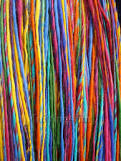Day 5 = August 17, 2014
Tonight I have the conclusion of the great 46 Interesting Facts About ... Knitting. As a special treat I have 6 facts for you tonight. WOW!! <---being sarcastic :)

41. Tricoteuse is French for “knitting woman.” During the French Revolution, a group of knitting women would sit beside the guillotine and knit through the executions. The Commune of Paris organized and paid these women to attend beheadings and tribunals “to greet death, to insult the victims, and to glut their eyes with blood.” They would jeer and shriek and knit as the upper class were led to the guillotine.h
42. In 1566, King Eric of Sweden owned 27 pairs of knitted silk stockings imported from Spain. Each knitted pair cost the same as his valet’s yearly salary.h
43. There were shepherds in the Landes swamps in France known as tchangues (“big legs”) who would knit on stilts while they watched their flocks. The need for stilt walking and shepherds were obliterated by the early 20th century when the government planted a forest of maritime pines over the swamps.h
44. The first knitting pattern book of any kind at all was the 16th-century Modelbuch, which was a printed pattern collection specifically for embroidery and lace. By the mid-17th century, patterns specifically for knitting were emerging within some pages of pattern books. In 1761, Susanna Dorothea Kriegl published an early pattern book devoted exclusively to knitting, the Strikkemøstre (Knitting Patterns).h
45. The term “Stitch-n-Bitch” has been used at least since WWII to refer to social knitting groups. It is also the title of a 2003 knitter’s handbook. Scholars note that these social groups often act as a form of resistance to major political, social, and technological change in Western societies.d
46. The countries of East Asia have no native history of hand knitting. Though hand and machine knitting now are popular there, knitting has come to them mostly through the modernization process in the 19th and 20th centuries.j
References
d Gardner, Sue, ed. 2007. A to Z of Knitting: The Ultimate Guide for the Beginner to Advanced Knitter. Woodinville, WA: Martingale & Company.h Nargi, Lela. 2011. Knitting around the World: A Multistranded History of a Time-Honored Tradition. Minneapolis, MN: Voyageur Press.
j Rutt, Richard. 1987. A History of Hand Knitting. London, UK: B.T. Batsford.
~~~
For today's Knitting Question of the Day,
Knitting from a 16th-Century Knitting Book,
Victoria
No comments:
Post a Comment